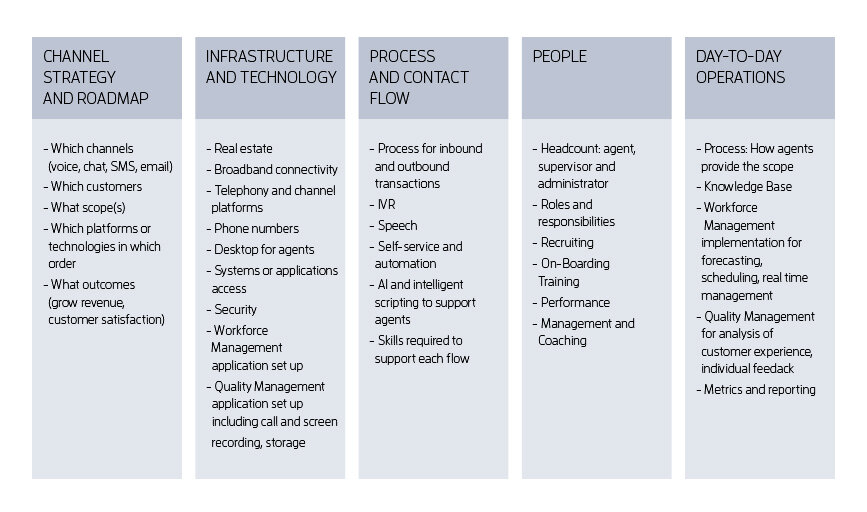A new Contact Center as a Service (CCaaS) platform affects every aspect of your organization. When thinking about making the transition, it’s helpful to consider how a platform change will impact channel strategy, infrastructure, process and contact flow, people, and day-to-day operations. These five pillars capture the key operating principles and provide a checklist that will make the transition as seamless as possible.
Within each pillar, there are critical questions you can pose to assess where you may need a better roadmap. Beginning with channel strategy, identifying which channels, which customers, and what scope the center or team will provide a great start towards understanding the complexity of your landscape. You should also ask whether a transition introduces new channels, what platforms or technologies are added in which order, and what outcomes are essential for the organization, to provide insights into business value that can show where to focus your efforts.
Below is a checklist of the pillars to guide your preparation.
Infrastructure and technology are well-known to be some of the more complex challenges because of the number of internal and external stakeholders that are typically involved. Effective planning in this arena means identifying stakeholders for each category early and ensuring that decision-makers are aligned about the preparation required leading up to go-live and for the transition itself.
One of the pillars many organizations underestimate is the impact of new platforms or technology on process and contact flow. While contact flow typically gets attention because of new messaging or IVR capabilities, real opportunities exist when you can step back and look at skills, knowledge bases, integration with other applications, and the benefits of AI and intelligent scripting to improve the customer experience.
People are frequently top of mind in transition scenarios, with significant time spent thinking through the timing of a transition, the training required, and the reinforcement needed. Involving representatives of each group affected by the transition is an effective technique to anticipate impacts, test new processes and flows, and generate momentum leading up to the transition. These inputs can lead to effective change management and communication plans that support the organization through the change. People involved should understand why the organization is doing this, how each person is affected, and what the new expectations will be.
Day-to-day operations requires a vision of both how the work is changing for leaders and staff teams and how they will need to perform the work after the transition. Often more metrics and analytics are becoming available – leading to new opportunities to interpret data, coach individuals, and identify overarching process trends and opportunities. While Workforce Management (WFM) and quality management (QM) teams are gaining new tools and insights, successful organizations ensure they have time to learn the new systems and practice during the ramp-up.
Bringing these elements together while considering technology options also helps pinpoint what really matters in your decision-making process and in your planning for implementation and ongoing support.
Want to brainstorm your needs and approach for a contact center transition? We’re happy to share our experiences and help you plan for success.
______________
Melissa Copeland is the Founder and Principal of Blue Orbit Consulting, a firm that specializes in effective strategies, targeted metrics and tailored programs to drive transformation in customer service and IT environments.



